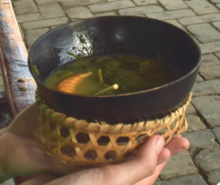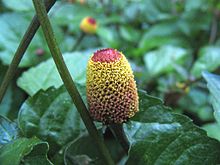Jambú
| Jambú | ||||||||||||
|---|---|---|---|---|---|---|---|---|---|---|---|---|

Jambú ( Acmella oleracea ) |
||||||||||||
| Systematics | ||||||||||||
|
||||||||||||
| Scientific name | ||||||||||||
| Acmella oleracea | ||||||||||||
| ( L. ) RKJansen |
With Jambu or Jambu [ ʒãbu ] is in Brazil , the plant Acmella oleracea in the family Asteraceae referred (Asteraceae).
The German term "Parakresse", which is sometimes used, is misleading, as it suggests belonging to the cruciferous family . A. oleracea is only known from culture, Peru is assumed to be its home . In English it is called Toothache Plant ("toothache plant") because of its pain-numbing effect , and because of the shape of the flower heads there is also the name Eyeball Plant ("eyeball plant"). Also because of the shape of the flower heads, like some other plant species, it is called “Hussar button” in German. Other popular names are "Paracress herb" and "Prickelknopf". You can buy the flower heads as "Sechuan buttons" in wholesale markets. However, they have a short shelf life.
Sometimes other species of the genus Acmella and Blainvillea acmella (Syn .: Spilanthes acmella ) are also referred to as "Jambú", but are of no great importance for commercial cultivation. Also Tilesia baccata (Syn: Wulffia stenoglossa ) is designated as such.
description
Acmella oleracea is an annual , prostrate to erect and herbaceous plant . It is about 20-80 centimeters high. The opposite, triangular to egg-shaped or slightly heart-shaped and stalked leaves are simple and have a whole to mostly notched or serrated, sometimes spiky-tipped leaf margin and are pointed to pointed or rounded. The petiole is 2–6.5 inches long and the weak to slightly hairy leaves 5–10.5 inches. The threefold vein is embossed in relief on the top.
More or less conical, egg-shaped, small, long-stemmed and 1.5-2.5 centimeters large, cup-shaped , axillary inflorescences are formed. There are really just a lot of yellow, hermaphrodite florets with initially reddish chaff sheets trained and there is a dreikreisiger Hüllkech present. There are two to three scar branches . The fruits are blackish, 2–2.5 millimeter long achenes with pappus and carpopodium . This species is very sensitive to frost.
use

Cooked jambu leaves are used in the north of Brazil for various traditional dishes, especially in connection with tucupi , e.g. B. Pato no Tucupi (duck and jambu vegetables, cooked in tucupi), or the soup Tacacá , a broth made from tucupi, with salted prawns, jambu and goma (cassava starch mixed into a jelly-like mass ), both culinary specialties in the Belém region . Jambu leaves create a “tingling”, slightly numbing feeling at the tip of the tongue that is unusual for the European palate.
Jambu leaves are believed to have anti-inflammatory properties; antibacterial effects could not be proven. The plants are used in folk medicine against rheumatism , gout , gingivitis and skin fungus. If the leaves are chewed raw, the tongue begins to tingle after a few seconds, similar to the effect of effervescent powder , with an aromatic herbal taste spreading. Acmella oleracea is also used as a biological insecticide and acaricide .
ingredients
The local anesthetic effect is attributed to spilanthol , a carboxamide .
literature
- Nicholas Hind, Nicki Biggs: Plate 460. Acmella Oleracea Compositae. In: Curtis's Botanical Magazine . Volume 20, Issue 1, 2003, doi: 10.1111 / 1467-8748.00368 , online at academia.edu.
- James A. Duke: Duke's Handbook of Medicinal Plants of Latin America. CRC Press, 2009, ISBN 978-1-4200-4316-7 , pp. 13-15, 740, 833 f.
- TK Lim: Edible Medicinal And Non-Medicinal Plants. Vol. 7: Flowers , Springer, 2014, ISBN 978-94-007-7394-3 , pp. 163-174.
- G. Frerichs, G. Arends , H. Zörnig: Hagers Handbook of Pharmaceutical Practice. Second volume, Springer, 1927, 1938, ISBN 978-3-662-35502-2 (reprint), p. 755.
- H. Hager : Commentary on the Pharmacopoeia Germanica. Volume 2, Springer, 1874, p. 144.
Web links
- Acmella oleracea at PROTA.
- Gernot Katzers spice pages, article about "Parákresse" with photos
- Synonyms of Acmella in Multilingual Multiscripted Plant Name Database (MMPND)
- A Toothache Plant Acmella oleracea at Website of Arthur Lee Jacobson
- Acmella oleracea in the Germplasm Resources Information Network (GRIN), USDA , ARS , National Genetic Resources Program. National Germplasm Resources Laboratory, Beltsville, Maryland.
- Jambú - Acmella oleracea in ethnobotany.
Individual evidence
- ^ FB da Souza: Pará e Amazonas. 1. a Parte, Typographia nacional, 1874, p. 114.
- ↑ Theodoro JH Langaard: Novo Formulario Medico e Pharmaceutico. Laemmert, 1872, p. 39 ff.
- ^ Arquivos do Jardim Botânico do Rio de Janeiro. Vol. VII, 1947, p. 113, online (PDF; 8.9 MB).
- ↑ James A. Duke.
- ^ Daniel F. Austin: Florida Ethnobotany. CRC Press, 2004, ISBN 978-0-203-49188-1 , pp. 62 f.
- ↑ An Index of Common Names of Plants in Acre, Brazil at New York Botanical Garden.
- ^ Enciclopédia Agrícola Brasileira. Vol. 4: I-M , EDUSP, 2002, ISBN 85-314-0719-2 , p. 149.
- ↑ FB Holetz, GL Pessini, NR Sanches, DAG Cortez, CV Nakamura, BP Dias Filho: Screening of some plants used in the Brazilian folk medicine for the treatment of infectious diseases. In: Mem. Inst. Oswaldo Cruz. Rio de Janeiro, Vol. 97 (7), 2002, pp. 1027-1031, doi: 10.1590 / s0074-02762002000700017 .
- ↑ Birgitt Eltzel: Prickle test with paracress. Allotment gardeners show more than 250 different varieties in the Marzahner show herb garden . In: Berliner Zeitung . of September 8, 2011, p. 19.
- ↑ Patrícia Rosa de Oliveira, Luis Adriano Anholeto, Rodney Alexandre Ferreira Rodrigues, Gervásio Henrique Bechara, Karina Neoob de Carvalho Castro: The potential of Acmella oleracea (Jambu) extract in the control of semi-engorged Rhipicephalus sanguineus (Latreille, 1806) (Acari : Ixodidae) female ticks . In: International Journal of Acarology . tape 44 , no. 4–5 , 2018, ISSN 0164-7954 , p. 192–197 , doi : 10.1080 / 01647954.2018.1472637 .
- ↑ Shaiene C. Moreno, Geraldo A. Carvalho, Marcelo C. Picanço, Elisangela GF Morais, Rogério M. Pereira: Bioactivity of compounds from Acmella oleracea against Tuta absoluta (Meyrick) (Lepidoptera: Gelechiidae) and selectivity to two non-target species . In: Pest Management Science . tape 68 , no. 3 , 2012, p. 386-393 , doi : 10.1002 / ps.2274 .
- ↑ RS Ramsewak, AJ Erickson, MG Nair: Bioactive N-isobutylamides from the flower buds of Spilanthes acmella. In: Phytochemistry. Volume 51, Number 6, 1999, pp. 729-732, PMID 10389272 .
- ↑ K. Spelman, D. Depoix, M. McCray, E. Mouray, P. Grellier: The traditional medicine Spilanthes acmella, and the alkylamides spilanthol and undeca-2E-ene-8,10-diynoic acid isobutylamide, demonstrate in vitro and in vivo antimalarial activity. In: Phytotherapy research: PTR. Volume 25, number 7, 2011, pp. 1098-1101, doi : 10.1002 / ptr.3395 , PMID 22692989 , PMC 3374932 (free full text).
